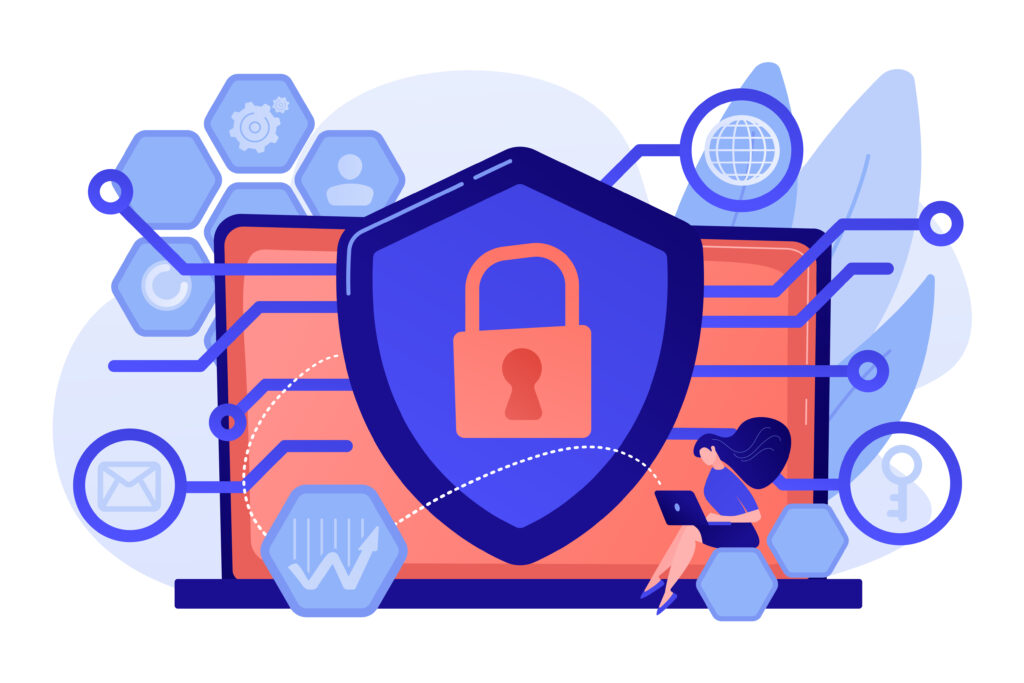Importance of Implementing Best Practices In Vulnerability Scanning
Looking for Vulnerability Scanning Best Practices is a crucial cybersecurity practice. It revolves around meticulously pinpointing potential security weaknesses within various facets of IT infrastructure such as systems, networks, and software.

This process employs advanced automated tools designed to systematically probe for vulnerabilities by cross-referencing extensive databases of known attack vectors and security issues.
By leveraging these tools, organizations can comprehensively assess their digital environment, uncovering vulnerabilities that could potentially be exploited by malicious actors. This proactive approach not only enhances overall security posture but also enables prompt remediation actions to mitigate risks effectively.
- Types of Vulnerability Scans
- Best Practices for Vulnerability
- Establishing a Comprehensive Vulnerability Scanning Framework
- Conducting Comprehensive Device Scans Across Your Ecosystem
- Adapting Scanning Frequency According to Risk Factors
- Prioritizing Remediation Based on Risk Assessment
- Maintaining Detailed Documentation of Scans and Results
- Establishing an Effective Vulnerability Remediation Process
- Thorough Investigation and Mitigation of False Positives
- Performing Rapid Re-Scans to Validate Remediation Effectiveness
Key Features of Vulnerability Scanning

Comprehensive Vulnerability Identification:
Vulnerability scanning meticulously identifies and reports security weaknesses across diverse IT landscapes, encompassing networks, hardware, software, and entire systems. This thorough assessment ensures that no potential vulnerability goes unnoticed, bolstering overall cybersecurity.
Automated Testing Capabilities:
Utilizing sophisticated automated tools, vulnerability scanning conducts rigorous tests to uncover potential weaknesses within IT assets. These automated tests streamline the detection process, enabling swift identification of vulnerabilities.
Detailed Reporting and Risk Assessment:
Vulnerability scanning generates in-depth reports that not only catalog discovered vulnerabilities but also provide comprehensive risk scores and actionable remediation guidance. These detailed insights empower organizations to prioritize and address vulnerabilities effectively.
Proactive Security Measures:
By proactively identifying and addressing security gaps, vulnerability scanning helps organizations fortify their defenses preemptively. This proactive approach is essential in mitigating risks before they can be exploited by malicious actors.
Compliance Assistance:

Vulnerability scanning plays a crucial role in regulatory compliance efforts, such as PCI DSS, HIPAA, and NIST, which mandate regular scanning. By facilitating adherence to these standards, organizations can ensure they meet stringent security requirements.
External Security Posture Evaluation:
Through unauthenticated scans, vulnerability scanning provides an external perspective on an organization’s security posture. Consequently, these scans simulate attacks from outside the network, thereby identifying vulnerabilities that may be visible to potential adversaries.
Enhanced Insight with Authenticated Scans:
Authenticated scans offer deeper insights by accessing systems behind login pages. This privileged access enables vulnerability scanning to uncover vulnerabilities that may not be visible during unauthenticated scans, providing a more comprehensive view of security risks.
These features highlight the critical role of vulnerability scanning in modern cybersecurity strategies, enabling organizations to proactively safeguard their digital assets against evolving threats.
Types of Vulnerability Scans:

Authenticated (Credentialed) Scans:
Authenticated scans necessitate valid credentials to access target systems fully. This type of scan provides comprehensive insights into vulnerabilities that may be obscured from unauthenticated scans.
Unauthenticated (Non-Credentialed) Scans:
Unauthenticated scans are conducted externally without the need for specific credentials or access rights. These scans focus primarily on identifying vulnerabilities that are visible from the outside, such as open ports, outdated software versions, and misconfigurations in network devices.
By simulating an external attack, unauthenticated scans provide an overview of vulnerabilities that could be exploited by external threats without the need for internal access privileges. Consequently, this type of scan is crucial for assessing an organization’s external security posture and identifying vulnerabilities that could be exploited from the internet-facing aspects of their infrastructure.
These distinct types of vulnerability scans cater to different aspects of security assessment, providing organizations with comprehensive insights into their overall security landscape and enabling targeted remediation efforts to mitigate potential risks effectively.
Best Practices for Vulnerability :

Establishing a Comprehensive Vulnerability Scanning Framework
Developing a robust vulnerability scanning framework involves creating a detailed and meticulously documented strategy that guides the entire lifecycle of vulnerability management within the organization. Furthermore, this framework serves as a foundational document that outlines the systematic approach from the initiation of vulnerability scans to the remediation of identified issues.
Initiation Phase: Define clear objectives and scope for vulnerability scanning activities. Specify the types of scans to be conducted (e.g., authenticated vs. unauthenticated), frequency of scans, and the systems and networks to be included in each scan cycle.
Planning and Preparation
Establish protocols for preparing systems and networks for scanning, including obtaining necessary permissions and credentials for authenticated scans. Develop procedures for scheduling scans to minimize disruption to business operations while ensuring thorough coverage.
Execution of Scans
Implement automated tools and methodologies to conduct comprehensive vulnerability scans across all targeted assets. Utilize network scanning tools, penetration testing techniques, and vulnerability databases to identify potential weaknesses in systems, networks, and applications.
Analysis and Reporting
Evaluate scan results to prioritize vulnerabilities based on severity ratings and potential impact on business operations. Generate detailed reports that include vulnerability findings, risk assessments, and recommended remediation actions. Ensure reports are tailored for different stakeholders, including technical teams, management, and compliance officers.
Remediation and Follow-Up
Establish clear guidelines and timelines for addressing identified vulnerabilities based on their severity levels. Define escalation procedures for critical vulnerabilities requiring immediate attention. Implement automated workflows and tools to streamline the remediation process and track progress towards closing identified security gaps.
Continuous Improvement
Regularly review and update the vulnerability scanning framework to incorporate lessons learned from past scans, changes in technology or business operations, and emerging threat landscapes. Foster a culture of continuous improvement by soliciting feedback from stakeholders and integrating best practices from industry standards and regulatory requirements.
Conducting Comprehensive Device Scans Across Your Ecosystem

To effectively manage cybersecurity risks, conducting thorough device scans across your network ecosystem is crucial. This process involves using manual audits, advanced network scanning tools, and robust asset management systems to maintain an accurate inventory of all connected devices.
Begin with manual audits to identify and document all devices, including desktops, servers, network appliances, IoT devices, and endpoints. Utilize sophisticated network scanning tools to automate discovery and mapping, identifying active devices, open ports, and potential security risks. Implement robust asset management systems to centralize device information, tracking types, specifications, software versions, and ownership details.
Prioritize scanning based on device type, criticality to operations, location within the network (e.g., DMZ), and associated risks, scanning critical devices more frequently. Ensure comprehensive coverage of all networked devices, updating inventory regularly to maintain accuracy.
Integrate device scans with vulnerability assessments to align identified risks with specific devices, facilitating targeted remediation efforts. Establish continuous monitoring to detect configuration changes and emerging vulnerabilities, adapting scanning procedures and asset management practices to evolving threats.
By conducting structured device scans, organizations can proactively mitigate risks, strengthen cybersecurity posture, and meet regulatory compliance requirements.
Adapting Scanning Frequency According to Risk Factors

Adapting vulnerability scanning frequency is crucial for effective cybersecurity, tailored to your organization’s specific risks. Consider network complexity, device criticality, emerging threats, and compliance requirements to optimize resource allocation and threat mitigation efforts.
1. Network Complexity:
Assess your network architecture’s intricacy and scale to determine scanning frequency. Complex networks with many interconnected devices may need more frequent scans for comprehensive coverage and timely vulnerability identification.
2. Device Criticality:
Prioritize scans based on devices critical to business operations and data security. Critical devices handling sensitive information or essential services require more frequent and thorough scanning to minimize disruptions and data breaches.
3. Evolving Threat Landscapes:
Stay updated on cybersecurity threats impacting your organization. Adjust scan frequency in response to emerging risks like new vulnerabilities or exploit techniques threatening network infrastructure.
4. Compliance Requirements:
Adhere to regulatory standards (e.g., PCI DSS, HIPAA, GDPR) mandating regular vulnerability assessments. Align scanning schedules with compliance needs to avoid penalties and security breaches.
5. Optimized Schedule:
Develop a balanced scan schedule—weekly for rapid response to critical vulnerabilities, monthly and quarterly for ongoing network security assessment.
6. Resource Efficiency:
Focus scans on high-risk areas and critical devices, utilizing automated tools to streamline operations and improve vulnerability management.
7. Continuous Improvement:
Regularly evaluate scan effectiveness based on feedback, vulnerability trends, and organizational changes. Adjust schedules to address evolving risks, ensuring proactive cybersecurity measures are maintained.
By adapting vulnerability scanning to these factors, organizations enhance their ability to promptly detect and mitigate security threats, safeguard data, ensure operational continuity, and bolster overall cybersecurity resilience.
Prioritizing Remediation Based on Risk Assessment

Effectively prioritizing remediation efforts is crucial in managing cybersecurity risks. Utilize standardized scoring systems such as the Common Vulnerability Scoring System (CVSS) to evaluate the severity of identified vulnerabilities.
Assess risks based on criteria including the availability of active exploits, potential impact on business operations, data integrity, service availability, and compliance with regulatory requirements.
1. CVSS Scoring:
Apply the CVSS framework to assign scores to vulnerabilities, considering factors like exploitability, impact metrics (confidentiality, integrity, availability), and environmental metrics (collateral damage potential, target distribution).
2. Risk Evaluation:
Conduct a thorough risk assessment to determine the criticality of vulnerabilities to your organization. Consider factors such as the likelihood of exploitation, potential business impact, and regulatory implications.
3. Priority Setting:
Prioritize remediation efforts based on the severity of vulnerabilities identified. Address high-risk vulnerabilities promptly to minimize exposure to potential threats and allocate resources effectively.
4. Resource Allocation:
Optimize resource allocation by focusing on vulnerabilities that pose the greatest risk to your organization’s operations and data security. Allocate time and manpower according to the urgency and potential impact of each vulnerability.
5. Continuous Monitoring:
Implement continuous monitoring to track remediation progress and identify any new vulnerabilities that may emerge. Regularly review and update your prioritization strategy based on evolving threat landscapes and organizational changes.
By prioritizing remediation efforts based on rigorous risk assessment methodologies, organizations can enhance their resilience against cyber threats, safeguard critical assets, and maintain regulatory compliance.
Maintaining Detailed Documentation of Scans and Results

Thorough documentation of vulnerability scans is essential for effective cybersecurity management. Capture comprehensive details of each scan, including identified vulnerabilities, risk assessments using tools like the Common Vulnerability Scoring System (CVSS), and actions taken for remediation.
1. Comprehensive Records:
Document all aspects of vulnerability scans, from initial findings to remediation progress. Include vulnerability details such as severity ratings, affected systems, and potential impacts on business operations and data security.
2. Risk Assessments:
Conduct detailed risk assessments to prioritize vulnerabilities based on their potential impact and exploitability. Use standardized scoring systems like CVSS to assign severity levels consistently.
3. Remediation Actions:
Record remediation actions taken for each identified vulnerability. Document timelines, responsible parties, and verification of fixes to ensure effective mitigation.
4. Accessibility:
Ensure the accessibility of scan records to relevant stakeholders, including technical teams, management, and auditors. By doing so, this accessibility not only facilitates compliance efforts with regulatory requirements but also enables informed decision-making regarding cybersecurity strategies.
5. Progress Tracking:
Use documented records to track remediation progress over time. Monitor trends in vulnerability detection and resolution to improve cybersecurity posture continually.
By maintaining detailed documentation of scans and results, organizations enhance their ability to manage cybersecurity risks proactively. Moreover, they demonstrate compliance with regulatory standards and effectively communicate remediation efforts across the organization.
Establishing an Effective Vulnerability Remediation Process

Creating a structured approach to vulnerability remediation is crucial for maintaining robust cybersecurity practices. Start by defining clear severity levels for identified vulnerabilities and establish corresponding remediation timelines.
For example, critical vulnerabilities demanding immediate attention might require remediation within 24-48 hours, whereas lower-severity issues could be addressed within longer timeframes, tailored to organizational priorities and resource availability.
Firstly, severity Classification:
Classify vulnerabilities using standardized frameworks like the Common Vulnerability Scoring System (CVSS) to determine their impact on business operations, data integrity, and regulatory compliance. Additionally, this process involves assigning severity levels based on exploitability, potential impact metrics, and environmental factors.
Secondly, timely Remediation:
Implement structured timelines for remediation based on vulnerability severity. Utilize automated tools and workflows to streamline the remediation process, ensuring efficient response times and minimizing potential risks associated with delayed fixes.
Thirdly, resource Optimization:
Optimize resource allocation by focusing remediation efforts on high-priority vulnerabilities that pose significant risks to the organization. Allocate resources effectively to address critical vulnerabilities promptly, while managing less urgent issues based on available resources and strategic priorities.
Finally, continuous Improvement:
Continuously monitor and refine the remediation process based on feedback from ongoing vulnerability scans and emerging threat landscapes. Adapt remediation strategies to mitigate evolving cybersecurity risks effectively and improve overall response capabilities over time.
By establishing an effective vulnerability remediation process, organizations can enhance their resilience against cyber threats, maintain operational continuity, and uphold compliance with regulatory requirements.
Thorough Investigation and Mitigation of False Positives

Addressing false positives effectively is essential to maintaining the accuracy and reliability of vulnerability assessments. Follow a systematic approach to investigate and mitigate suspected false positives identified during vulnerability scans.
1. Detailed Review:
Begin by conducting a comprehensive review of scan results to identify potential false positives. Next, analyze the specifics of each identified vulnerability and cross-reference them with current system configurations and recent updates.
2. System Analysis:
Perform detailed analysis of affected systems to validate whether identified vulnerabilities are genuine or result from misconfigurations, outdated information, or other non-threatening factors.
3. Vendor Consultation:
Consult, therefore, with relevant vendors or cybersecurity communities to verify findings. Additionally, this helps obtain insights into potential misinterpretations or inaccuracies in vulnerability assessments.
4. Preventive Measures:
To begin with, it is essential to implement measures that minimize the occurrence of false positives in future scans. Specifically, this includes regularly updating scanning tools and databases. Additionally, refining scanning parameters and enhancing configuration management practices are crucial steps in achieving this goal.
5. Documentation and Communication:
Document all findings and actions taken during the investigation of false positives. Ensure clear communication of results to technical teams, management, and stakeholders to facilitate informed decision-making and continuous improvement of vulnerability management practices.
By conducting thorough investigations and implementing preventive measures, organizations can improve the accuracy of vulnerability assessments, optimize resource utilization, and strengthen overall cybersecurity defenses against genuine threats.
Performing Rapid Re-Scans to Validate Remediation Effectiveness

Conducting rapid re-scans after addressing critical or high-severity vulnerabilities is essential to validate the effectiveness of remediation efforts and ensure ongoing security resilience.
1. Immediate Validation:
Firstly, immediately after applying fixes to critical or high-severity vulnerabilities, initiate rapid re-scans of affected systems. This proactive approach confirms that remedial actions have effectively mitigated identified vulnerabilities.
2. Verification Process:
During re-scans, verify that previously identified vulnerabilities have been successfully resolved and that no new vulnerabilities have emerged due to remediation efforts. This verification process ensures that the organization’s attack surface remains minimized and that security measures are robustly maintained.
3. Comprehensive Documentation:
4. Enhanced Security Posture:
By performing rapid re-scans, organizations enhance their overall security posture. This approach not only validates the efficacy of remediation efforts but also supports continuous improvement of cybersecurity practices in response to evolving threats.
5. Continuous Monitoring:
Finally, integrate rapid re-scanning into ongoing vulnerability management processes to maintain vigilance against emerging threats and ensure prompt response to any potential security vulnerabilities.
By incorporating rapid re-scans into vulnerability management practices, organizations strengthen their resilience against cyber threats, mitigate risks effectively, and uphold robust security standards across their operations.
[Want to learn more on Vulnerability Scanning Best Practices for your business? Click here to reach us.]
Conclusion
In conclusion, effective vulnerability scanning practices are fundamental to robust cybersecurity frameworks, crucial for safeguarding organizational assets against evolving threats. Bobcares offers specialized support services that empower businesses to navigate cybersecurity complexities with confidence.
By adopting a systematic approach that includes establishing a detailed scanning framework, conducting thorough device assessments across network ecosystems, and adapting scanning frequencies based on risk factors, organizations can proactively identify and mitigate potential security vulnerabilities.
Thorough documentation, meticulous investigation of false positives, and rapid re-scans to validate remediation effectiveness are essential components of this approach. These practices not only enhance security postures but also support regulatory compliance efforts, ensuring businesses mitigate risks effectively while maintaining operational resilience.
As cyber threats evolve, continuous refinement of vulnerability scanning strategies is essential. Integrating these best practices into cybersecurity strategies ensures organizations can bolster their defenses and maintain trust in an interconnected digital world. Partnering with Bobcares provides expert guidance to stay ahead in securing critical assets effectively.







0 Comments